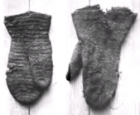Two Icelandic Mittens (1896).
TRANSLATED BY ÁSFRÍÐR ULFVÍÐARDÓTTIR/ REBECCA LUCAS.
The brief mention Hald (1980; 302-3) gave to a 'woven cloth' Viking-age mitten originated with these two articles. The first, in Icelandic, was:
Pálsson, P. (1895) Um myndir af gripum í forngripasafninu Árbók Hins íslenzka fornleifafélags 10;30-35.
A year later, a summary was published in German, with drawings copying the photographs of Pálsson:
Lehmann-Filhés, M. (1896) Zwei Isländische Handschuhe Zeitschrift für Ethnologie; 29-30.
Pálsson, P. (1895) Um myndir af gripum í forngripasafninu Árbók Hins íslenzka fornleifafélags 10;30-35.
A year later, a summary was published in German, with drawings copying the photographs of Pálsson:
Lehmann-Filhés, M. (1896) Zwei Isländische Handschuhe Zeitschrift für Ethnologie; 29-30.
I have translated the article by Lehmann-Filhés, below. I hope that this translation is accurate, but I am not going to guarantee that it is error free. If in doubt, refer to the original texts -- now in the public domain -- in Icelandic and German.
Thank-you to Eva!
Thank-you to Eva!
Miss Margarethe Lehmann Filhés sends a Communication about Two Icelandic Mittens.
In the 1895 Árbók Hins íslenzka fornleifafélags, Pálmi Pálsson wrote about two mittens (vettir, vetlingar = mitts) that are found in the Reykjavík Museum. One of them (Fig. 1) was found on the Akranes peninsula, north of Reykjavík, in 1881. On the lawn of a 5.5 cubit-high hill, there stood a shed and storehouse. When it was excavated, it appeared the hill consisted completely of the debris of houses; Over the centuries, new buildings had been constructed atop the ruins of previous structures. Upon reaching the level of the surrounding grass field, a paved floor was struck and here lay the mitten near a small basin-stone [Schalenstein, possibly a cup-marked stone?]. Not far away, at the same depth, there was a portion of a soft, slimy mass, that sadly was not further investigated; probably it was skyr (A popular Icelandic dish, made from cultured milk).
The mitten obviously comes from the time when the original house was still standing. The farmstead [garðar] is on the Norse landnám period land [Landnahmeerde/landnámsjörð, ca. 874-930 CE.]; here lived Jörundur the Christian, son of the Irishman Ketill, who took possession of Akranes. The homestead at that time was called Jörundarholt. The mitten is of woven fabric, finished with a very thick weft, and a fine warp. The thumb is inset and likewise is a gore, the latter widening the cuff from the hand portion.
The mitten is red-brown, probably dyed with moss; its' length is 28 cm [and 11 cm wide (Pálsson, 1895)], but it appears to originally have been longer and worn over the sleeve, as neither seam, nor finishing edging is present, and the wrist is unusually wide. It belongs on the left hand. The figure shows the outer palm.
The second mitten (Fig. 2) was discovered in 1889 in Arneiðarstaðir, Fljótsdalhérad, east Iceland. The soil underneath a house, whose foundation was excavated in order to erect a new building and two others, revealed objects belonging to antiquity laying there. It is 26 cm long [and 12 cm wide (Pálsson, 1895)], naalbinded [gehäkelt, lit. crocheted] of thick plied [? gezwintem] yarn, so you can clearly see the edge where the last round of stitches stopped, the colour a little darker than the previous one. The figure shows the inner palm. [The slit seen on the palm of the mitten is small, and is from damage, not by design (Pálsson, 1895)]
Pálmi Pálsson believes that both mittens are from the same time, being the 10th century. He came to find it noteworthy that neither were knitted, from whence he concludes that the art of knitting was unknown in earlier times in Iceland. Nor could one find mention of knitting in the old literature.
http://medieval-baltic.us/lehmann-filhes-palsson.html


Left: Photograph of mittens (Pálsson, 1895). Right: Drawing of mittens (Lehmann-Filhés, 1896).
There is a colour photo of what appears to be the naalbinded mitten at this stock photography site.

Aucun commentaire:
Enregistrer un commentaire